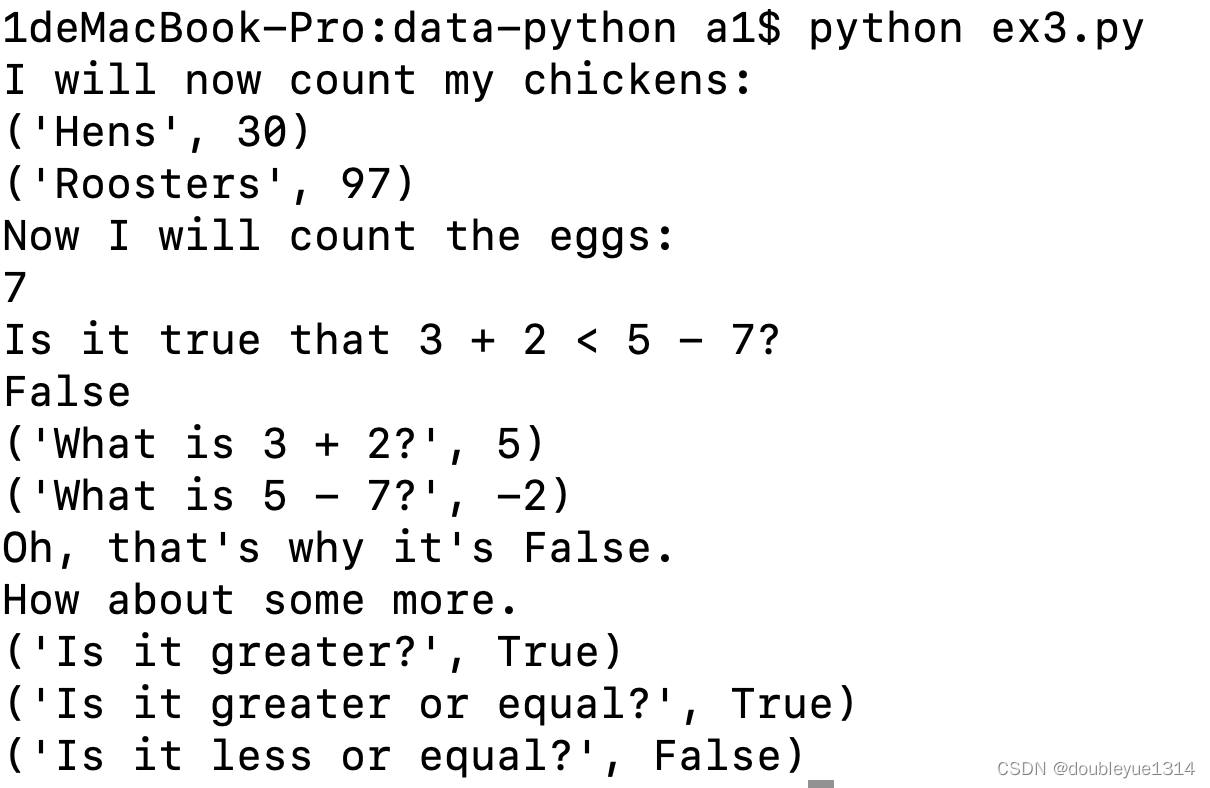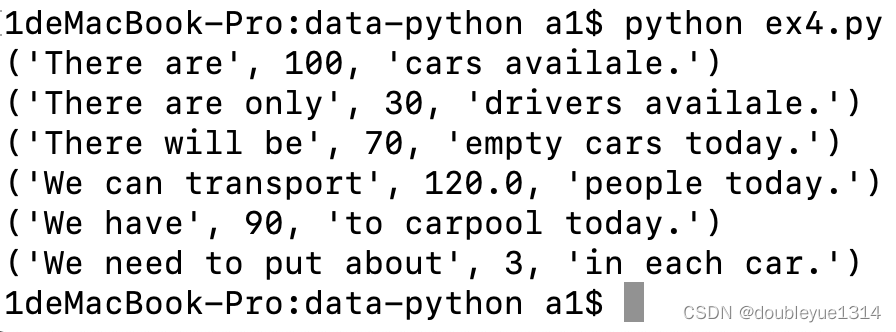写在前面
三十而立之年,开始自学数据分析,工作比较清闲,现发帖记录自己的数据分析之路,数据分析要学很多的东西,经过多月的摸索,目前分两个方面开始学习:
·知识方面:数学为王,拿起书本,重学《概率与统计》、《微积分》、《线性代数》
·软件方面:MySQL、Python
将暂时更新这几个序列,以便记录。
此篇为《笨办法学Python》,全书共52个习题,纯手工码字,视内容多少,分批次发布。
习题0——准备工作
主要是讲解在不同操作系统下安装好Python:
1、下载python:http://www.python.org/downloads,官网下载适合你版本的python,在此不多赘述
2、下载Atom:http://atom.io,找到并安装Atom
3、建议不论是Windows、MAC、还是Linux,都安装原始的Python练习,尽管以后我们会使用Anaconda,Pycharm,但是练好基础还是很有必要的
安装好后的界面
习题1——第一个程序
源代码:
print("Hello World!")
print("Hello Again")
print("I like typing this.")
print("This is fun.")
print('Yay! Printing.')
print("I'd much rather you 'no'.")
print('I "said" do not touch this.')
输出结果:

习题2——注释和#号
源代码:
# A comment, this is so you can read your program later.
# Anything after the # is ignored by python.
print("I could have code like this.") # and the comment after is ignored
# You can also use a comment to "disable" or comment out code:
# print("This won't run.")
print("This will run.")
运行结果:

习题3——数字和数学计算
源代码:
print("I will now count my chickens:")
print("Hens", 25 + 30 / 6)
print("Roosters", 100 - 25 * 3 % 4)
print("Now I will count the eggs:")
print(3 + 2 + 1 - 5 + 4 % 2 - 1 / 4 + 6)
print("Is it true that 3 + 2 < 5 - 7?")
print(3 + 2 < 5 - 7)
print("What is 3 + 2?",3 + 2)
print("What is 5 - 7?",5 - 7)
print("Oh, that's why it's False.")
print("How about some more.")
print("Is it greater?", 5 > -2)
print("Is it greater or equal?", 5 >= -2)
print("Is it less or equal?",5 <= -2)
运行结果:

习题4——变量和命名
源代码:
cars = 100
space_in_a_car = 4.0
drivers = 30
passengers = 90
cars_not_driven = cars - drivers
cars_driven = drivers
carpool_capacity = cars_driven * space_in_a_car
average_passengers_per_car = passengers / cars_driven
print("There are", cars, "cars availale.")
print("There are only", drivers, "drivers availale.")
print("There will be", cars_not_driven, "empty cars today.")
print("We can transport", carpool_capacity, "people today.")
print("We have", passengers, "to carpool today.")
print("We need to put about", average_passengers_per_car, "in each car.")
运行结果:

习题5——更多的变量和打印
源代码:
my_name = 'Zed A. Shaw'
my_age = 35 # not a lie
my_height = 74 # inches
my_weight = 180 # lbs
my_eyes = 'Black'
my_teeth = 'White'
my_hair = 'Black'
print(f"Let's talk about {my_name}.")
print(f"He's {my_height} inches tall.")
print(f"He's {my_weight} pounds heavy.")
print("Actually that's not too heavy.")
print(f"He's got {my_eyes} eyes and {my_hair} hair.")
print(f"His teeth are usually {my_teeth} depending on the coffee.")
# this line is tricky, try to get it exactly right
total = my_age + my_height + my_weight
print(f"If I add {my_age}, {my_height}, and {my_weight} I get {total}.")运行结果:
Let's talk about Zed A. Shaw. He's 74 inches tall. He's 180 pounds heavy. Actually that's not too heavy. He's got Black eyes and Black hair. His teeth are usually White depending on the coffee. If I add 35, 74, and 180 I get 289.
习题6——字符串和文本
源代码:
types_of_people = 10
x = f"There are {types_of_people} types of people."
binary = "binary"
do_not = "don't"
y = f"Those who know {binary} and those who {do_not}."
print(x)
print(y)
print(f"I said: {x}")
print(f"I also said: '{y}'")
hilarious = False
joke_evaluation = "Isn't that joke so funny?! {}"
print(joke_evaluation.format(hilarious))
w = "This is the left side of..."
e = "a string with a right side."
print(w + e)运行结果:
There are 10 types of people. Those who know binary and those who don't. I said: There are 10 types of people. I also said: 'Those who know binary and those who don't.' Isn't that joke so funny?! False This is the left side of...a string with a right side.
习题7——更多打印
源代码:
print("Marry had a little lamb.")
print("Its fleece was white as {}.".format('snow'))
print("And everywhere that Marry went.")
print("." * 10) # what'd that do?
end1 = "C"
end2 = "h"
end3 = "e"
end4 = "e"
end5 = "s"
end6 = "e"
end7 = "B"
end8 = "u"
end9 = "r"
end10 = "g"
end11 = "e"
end12 = "r"
# watch that comma at the end. try removing it to see what happens
print(end1 + end2 + end3 + end4 + end5 + end6, end = ' ')
print(end7 + end8 + end9 + end10 + end11 + end12)运行结果:
Marry had a little lamb. Its fleece was white as snow. And everywhere that Marry went. .......... Cheese Burger
习题8——打印,打印
源代码:
formatter = "{} {} {} {}"
print(formatter.format(1,2,3,4))
print(formatter.format("one","two","three","four"))
print(formatter.format(True, False, False, True))
print(formatter.format(formatter,formatter,formatter,formatter))
print(formatter.format(
"Try your",
"Own text here",
"Maybe a poem",
"Or a song about fear"
))运行结果:
1 2 3 4
one two three four
True False False True
{} {} {} {} {} {} {} {} {} {} {} {} {} {} {} {}
Try your Own text here Maybe a poem Or a song about fear
习题9——打印,打印,打印
源代码:
# Here's some new strange stuff, remember type it exactly.
days = "Mon Tue Wed Thu Fri Sat Sun"
months = "Jan\nFeb\nMar\nApr\nMay\nJun\nJul\nAug"
print("Here are the days: ", days)
print("Here are the months: ",months)
print("""
There's something going on here.
With the three double-quotes.
We'll be able to type as much as we like.
Even 4 lines if we want, or 5, or 6.
""")运行结果:
Here are the days: Mon Tue Wed Thu Fri Sat Sun Here are the months: Jan Feb Mar Apr May Jun Jul Aug There's something going on here. With the three double-quotes. We'll be able to type as much as we like. Even 4 lines if we want, or 5, or 6.
习题10——那是什么
源代码:
tabby_cat = "\tI'm tabbed in."
persian_cat = "I'm split\non a line."
backslash_cat = "I'm \\a \\ cat."
fat_cat = """
I'll do a list:
\t* Cat food
\t* Fishies
\t* Catnip\n\t* Grass
"""
print(tabby_cat)
print(persian_cat)
print(backslash_cat)
print(fat_cat)运行结果:
I'm tabbed in. I'm split on a line. I'm \a \ cat. I'll do a list: * Cat food * Fishies * Catnip * Grass





















 被折叠的 条评论
为什么被折叠?
被折叠的 条评论
为什么被折叠?








